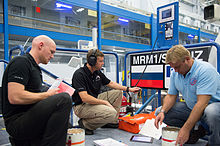
Soyuz TMA-8 was a Soyuz mission to the International Space Station (ISS) launched by a Soyuz FG launch vehicle.

Soyuz TMA-10 was a human spaceflight mission using a Soyuz-TMA spacecraft to transport personnel to and from the International Space Station (ISS). The mission began at 17:31:09 UTC on April 7, 2007 when the spacecraft was launched from the Baikonur Cosmodrome by a Soyuz FG launch vehicle. Soyuz TMA-10 brought to the station two members of ISS Expedition 15 crew, along with one spaceflight participant. It remained at the space station as an escape craft until it was replaced by Soyuz TMA-11 in October 2007.

Soyuz TMA-13 was a Soyuz mission to the International Space Station (ISS). The spacecraft was launched by a Soyuz-FG rocket at 07:01 GMT on 12 October 2008. It undocked at 02:55 GMT on 8 April 2009, performed a deorbit burn at 06:24, and landed at 07:16. By some counts, Soyuz TMA-13 is the 100th Soyuz spacecraft to be crewed.

Soyuz TMA-15 was a crewed spaceflight to the International Space Station. Part of the Soyuz programme, it transported three members of the Expedition 20 crew to the space station. TMA-15 was the 102nd crewed flight of a Soyuz spacecraft, since Soyuz 1 in 1967. The Soyuz spacecraft remained docked to the space station during Expedition 20 and Expedition 21 as an emergency escape vehicle. The mission marked the start of six-person crew operations on the ISS.

Soyuz TMA-19 was a crewed spaceflight to the International Space Station (ISS) and is part of the Soyuz programme. It was launched on 15 June 2010 carrying three members of the Expedition 24 crew to the International Space Station, who remained aboard the station for around six months. Soyuz TMA-19 was the 106th crewed flight of a Soyuz spacecraft, since the first mission which was launched in 1967. The spacecraft remained docked to the space station for the remainder of Expedition 24, and for Expedition 25, to serve as an emergency escape vehicle. It undocked from ISS and landed in Kazakhstan on 26 November 2010. It was the 100th mission to be conducted as part of the International Space Station programme since assembly began in 1998.
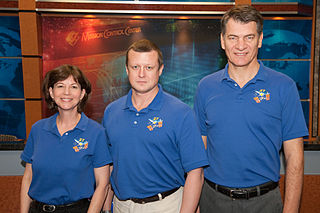
Soyuz TMA-20 was a human spaceflight to the International Space Station (ISS) and was part of the Soyuz programme. It lifted off from the Baikonur Cosmodrome in Kazakhstan on December 15, 2010, and docked with the ISS two days later. The three-person crew of Soyuz TMA-20 – Dmitri Kondratyev, Catherine Coleman and Paolo Nespoli – represented the ISS partner organizations of Roscosmos, NASA and the European Space Agency (ESA). Soyuz TMA-20's crew represented half of the members of Expedition 27; the other three members of the expedition arrived at the station on board Soyuz TMA-21 on April 6, 2011. The COSPAR ID of Soyuz TMA-20 was 2010-067A. It is ISS flight 25S.

Soyuz TMA-21 ("Gagarin") was a Soyuz flight to the International Space Station (ISS). It transported three members of the Expedition 27 crew to the ISS, and docked at the station on April 6, 2011. TMA-21 is the 109th flight of a Soyuz spacecraft, the first of which launched in 1967. The Soyuz remained attached to the space station as a lifeboat, throughout the remainder of Expedition 27 and through the end of Expedition 28, and returned to Earth on September 16, 2011.

Expedition 29 was the 29th long-duration expedition to the International Space Station (ISS). The expedition formally began on 16 September 2011, with the departure from the ISS of the Soyuz TMA-21 spacecraft. Astronauts Satoshi Furukawa, Michael Fossum and Sergey Volkov, who had arrived at the ISS aboard Soyuz TMA-02M in June 2011, began their Expedition 29 service at this time.

Soyuz TMA-02M was a space mission that transported three members of the Expedition 28 crew to the International Space Station. TMA-02M was the 110th flight of a Soyuz spacecraft and the second flight of the improved Soyuz-TMA-M series. The Soyuz remained docked to the space station for the Expedition 28 increment to serve as a potential emergency escape vehicle.

Soyuz TMA-03M was a spaceflight to the International Space Station (ISS). It launched on 21 December 2011 from Site One at the Baikonur Cosmodrome, Kazakhstan, carrying three members of Expedition 30 to the ISS. TMA-03M was the 112th flight of a Russian Soyuz spacecraft, since the first in 1967, and the third flight of the modernised Soyuz-TMA-M version. The docking with the International Space Station took place at 19:19 Moscow Time on 23 December, three minutes ahead of schedule.
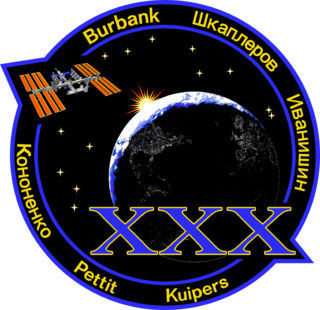
Expedition 30 was the 30th long-duration mission to the International Space Station (ISS). The expedition's first three crew members – Dan Burbank, Anton Shkaplerov and Anatoli Ivanishin – arrived on the ISS aboard Soyuz TMA-22 on 16 November 2011, during the last phase of Expedition 29. Expedition 30 formally began on 21 November 2011, with the departure from the ISS of the Soyuz TMA-02M spacecraft. The expedition ended on 27 April 2012, as Burbank, Shkaplerov and Ivanishin departed from the ISS aboard Soyuz TMA-22, marking the beginning of Expedition 31.

Soyuz TMA-05M was the 114th flight of a Soyuz spacecraft. It was launched on 15 July 2012, transporting three members of the Expedition 32 crew to the International Space Station (ISS). The Soyuz remained docked to the ISS throughout the mission to serve as an emergency escape vehicle. The launch also coincided with the 37th anniversary of the Apollo–Soyuz Test Project. Soyuz TMA-05M successfully returned to Earth on 19 November 2012.
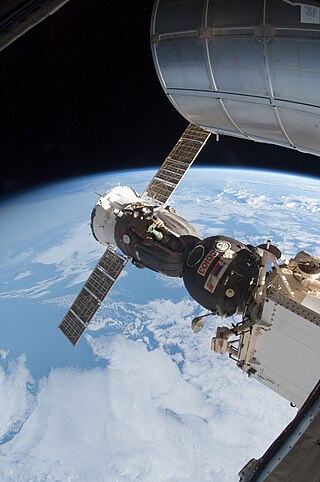
Soyuz TMA-07M was a spaceflight launched to the International Space Station in 2012 which transported three members of the Expedition 34 crew to the station. The Soyuz remained docked to the space station and served as an emergency escape vehicle for the Expedition 35 increment, before returning its crew to Earth in May 2013.

Soyuz TMA-09M was a Russian Soyuz mission to the International Space Station. It transported three members of the Expedition 36 crew to the space station. The Soyuz remained docked to the space station during Expeditions 36 and 37 to serve as an emergency escape vehicle. The spacecraft landed on 11 November 2013, carrying the same three cosmonauts who were aboard for launch. The crew of Soyuz TMA-09M consisted of Fyodor Yurchikhin of Roskosmos, Karen Nyberg of NASA and Luca Parmitano of the European Space Agency.

Expedition 40 was the 40th expedition to the International Space Station. A portion of the Expedition 39 crew transferred to Expedition 40 while the remainder of the crew launched on May 28, 2014 from Baikonur Cosmodrome in Kazakhstan.

Soyuz TMA-12M was a 2014 flight to the International Space Station. It transported three members of the Expedition 39 crew to the International Space Station. TMA-12M was the 121st flight of a Soyuz spacecraft since the first in 1967 and the 38th Soyuz mission to the ISS.

Soyuz TMA-14M was a 2014 flight to the International Space Station. It transported three members of the Expedition 41 crew to the International Space Station. TMA-14M is the 123rd flight of a Soyuz spacecraft, the first flight launching in 1967. The Soyuz remained docked to the space station for the Expedition 42 increment to serve as an emergency escape vehicle until undocking and landing as scheduled in March 2015.

Soyuz TMA-15M was a 2014 flight to the International Space Station. It transported three members of the Expedition 42 crew to the International Space Station. TMA-15M was the 124th flight of a Soyuz spacecraft, the first flight launching in 1967. The Soyuz remained docked to the space station for the Expedition 43 increment, serving as an emergency escape vehicle until departing and returning to Earth as scheduled in June 2015.
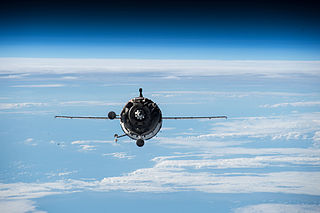
Soyuz TMA-16M was a 2015 flight to the International Space Station. It transported three members of the Expedition 43 crew to the Station. TMA-16M was the 125th flight of a Soyuz spacecraft, the first having launched in 1967.

Soyuz TMA-19M was a 2015 Russian Soyuz spaceflight to the International Space Station. It was launched on December 15, 2015 from Baikonur Cosmodrome, transporting three members of the Expedition 46 crew to the International Space Station. TMA-19M was the 128th flight of a Soyuz spacecraft since the first in 1967. The crew consisted of a Russian commander accompanied by American and British astronauts. The flight returned to Earth on June 18, 2016. The Soyuz TMA-19M descent module is now in the collection of the UK's Science Museum Group.

